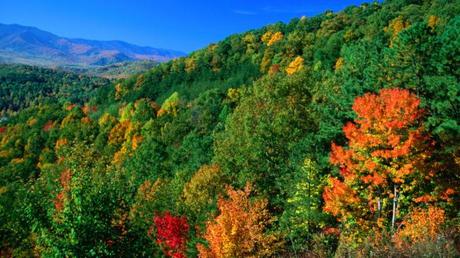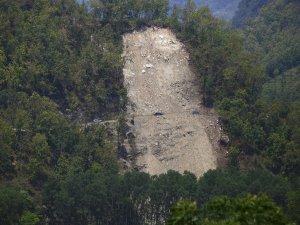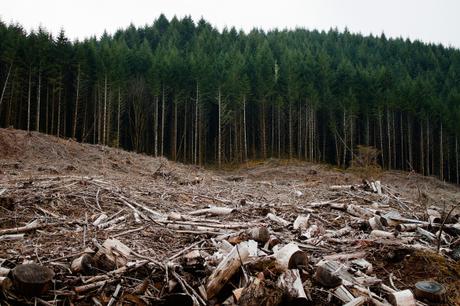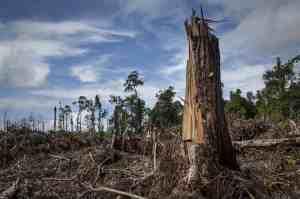Forests
Forests are long-lived communities of trees, shrubs, herbs, and wildlife. The communities form over centuries as birds and winds deliver seeds and spores to sites with sufficient moisture for big plants to grow. Across regions occupied by forests, annual precipitation and temperature usually varies from dry with small scattered trees to wet with dense forest with interlocked canopies.

Cherokee National Forest, Tennessee (Country Living)
As forests develop, soils form and a diverse assemblage of arthropods, amphibians, birds, mammals, and reptiles gathers to fill habitats from the ground up to the canopy. The animals interact with the plants, pollinating flowers, scattering seeds, and forming many novel alliances.
Forests and the litter that accumulates on the ground transform environments. They moderate temperature and they absorb and hold moisture from precipitation. They protect the land from extreme heat and flooding. Forests are much finer places to live than the bare rock and dirt upon which they form.

Landslide in Nepal (Navesh Chitrakar Reuters/Landov)
Forests exist in a dynamic equilibrium with the forces of nature. Across a forest, natural events, fires, windstorms, floods, droughts, and late freezes, are often annual occurrences. These create a mosaic of forest of varying age. In tropical regions with stable climate, forests are older and more uniform in age than they are in temperate regions with variable climate.
Harvesting the Earth: Deforestation
Over the past few millennia, humans have accelerated forest dynamics. We have cut and burned to destroy patches of forest at a higher rate than natural forces ever did. We are doing these things so often, the forests do not have time to recover. And in many instances, we create and maintain crops and plantations that insure the forests will never recover.
Loggers and ranchers cut forests for lumber, and cut or burn forests for livestock pastures, plantations, and farms. In the U. S., the Forest Service, Bureau of Land Management, and state forestry departments help timber companies maximize their profits by permitting clear cutting, and by building roads and erosion barriers. With the loss of trees and disturbance of the soil, flooding and erosion often increase. Habitat and wildlife are always lost.

Clearcut forest in Oregon.
According to the World Wildlife Fund, more than half of all animals on Earth have disappeared during the past 50 years (WWF 2016). Deforestation and other human activities are responsible.
Government agencies build roads to ease removal of the forests, and they pay ranchers to build fences and stock watering ponds. Sometimes they attempt to mitigate the harmful effects of tree removal by cutting terraces into the soil to slow runoff and by planting replacement trees. In few or no instances do the agencies give the planted trees enough time to regenerate the original forest before they are cut again.
Global Deforestation

A peatland forest clearing for a palm oil plantation in the Leuser ecosystem, South Aceh, Indonesia. Photograph: Ulet Ifansasti/Getty Images
Deforestation is ongoing around the world as cutting and burning convert forests to pastures, farms, and plantations. For example, Arthur Neslen of the Guardian reports, “Europe’s contribution to global deforestation may rise by more than a quarter by 2030, despite a pledge to halt such practices by the end of this decade, according to a leaked draft EU analysis.
“An estimated 13m hectares (Mha) of the world’s forestland is lost each year, a figure projected to spiral in the next 30 years with the Amazon, Greater Mekongand Borneo bearing the brunt of tree clearances.
“But despite signing several international pledges to end deforestation by this decade’s end, more than 5Mha of extra forest land will be needed annually by 2030 to meet EU demand for agricultural products, a draft EU feasibility study predicts.” –Arthur Neslen (Source: Europe’s contribution to deforestation set to rise despite pledge to halt it | Environment | The Guardian)
Justifying Deforestation
People sometimes justify removing the forest as the unavoidable costs of human progress toward a better life of increased comfort and security. In most instances today, however, for-profit companies remove forests with little concern for people’s lives or the consequences for soils and wildlife.
The counter argument that the forest, every tree, and all the animals of the forest have value independent of humans is rarely heard. Here’s how Judi Bari put it:
“Deep ecology, or biocentrism, is the belief that nature does not exist to serve humans. Rather, humans are part of nature, one species among many. All species have a right to exist for their own sake, regardless of their usefulness to humans. And biodiversity is a value in itself, essential for the flourishing of both human and nonhuman life.
“These principles, I believe, are not just another political theory. Biocentrism is a law of nature, that exists independently of whether humans recognize it or not. It doesn’t matter whether we view the world in a human centered way. Nature still operates in a biocentric way. And the failure of modern society to acknowledge this – as we attempt to subordinate all of nature to human use – has led us to the brink of collapse of the earth’s life support systems.” –Judi Bari (Revolutionary Ecology)
Humans have cut and burned forests for thousands of years. The delightfully moderate environments created by forests, the opposite of urban heat islands or the monotony of farms, are disappearing. In our own special way, we are fouling our nest, but unlike the birds, we are not cleaning up after ourselves.
You can expand on this rambling introduction to deforestation by reading more posts on this blog or by reading many of the fine books available on Amazon.
Previous Posts (84) in this blog describe events and consequences for sites around the world.

